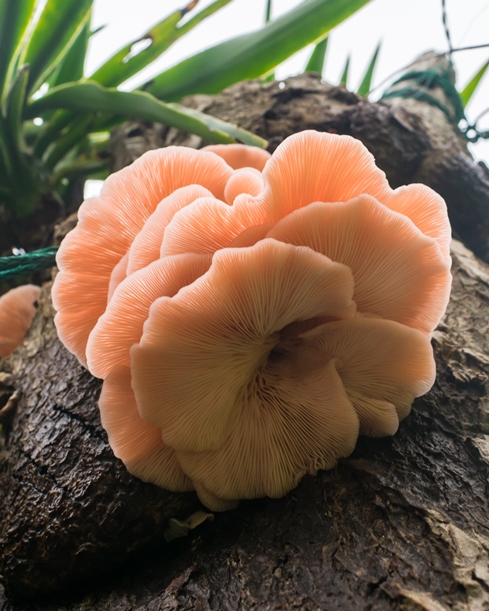Pleurotus djamor, a beautiful find practically on our doorstep! We found it in a tree here in the backyard of the house we rent in the city center. It’s commonly known in English as the Pink oyster mushroom.
Characteristics of Pleurotus djamor mushroom



This mushroom is quite easy to identify. It usually has a beautiful pink/salmon color, but I’ve read that it can have other colors that are a bit whiter to beige, and when it gets older it gets a little paler and can also lose a lot of its color. We found three “groups” on this tree, and you could see that one was younger and had a much more pronounced color than the others.
It grows on dead wood in tropical forests around the world. When we saw these on this tree that looked well and alive, we thought it was strange, but looking closer we saw that in fact several parts of the trunk were already “soft”, in a stage of decomposition. I believe that this tree is of the Yucca genus.
When it’s mature its diameter varies from 2 to 10 cm. The ones we found were quite large, the largest was 10 cm. The stipe (“stem”) is very short or non-existent. The hymenophore (underside) has beautiful lamellae that are decurrent (they run from the underside to the stem without clear separation).
Pleurotus djamor – a very popular edible mushroom



This is a wild edible mushroom, like most species of the Pleurotus genus, and it’s also widely cultivated and appreciated – I read that it’s the 3rd most produced edible mushroom in the world! It seems to adapt well to various types of substrates, making it easy to grow. It’s also commonly sold within a Mushroom Grow Kit to grow at home.
Moreover, this is a mushroom traditionally consumed by the Sanöma indigenous people, from the Yanomami ethnic group of the Amazon, who call it by the name “hiwala amo” which means porcupine (I would like to understand the reason of this name, lol).
And like other mushrooms of the Pleurotus genus, it has a high nutritional value, with a high content of proteins, essential amino acids, a high proportion of unsaturated fatty acids, various vitamins and minerals, as well as low levels of fats, nucleic acids, sugars and calories.
In addition, it also has medicinal properties, with research indicating that it has antibiotic, antioxidant, antidiabetic, anti-inflammatory properties, among others. It also has possible uses in the environmental area, such as in the treatment of organic waste, and decomposing pollutants present in soil and water.
Preparing and tasting the Salmon Mushroom



Anyway, it’s a privilege to be able to find and harvest these beautiful mushrooms, and even come across them right here in our backyard. Like all mushrooms, there are several possible ways to prepare them, but the most common is to sauté or stir-fry them.
While researching online I read that they can be eaten raw in salads, but on the Wikipedia I found information that they have a sour taste when raw. I didn’t end up trying them raw, so I can’t give an opinion on that.
We cleaned them with a little brush to remove any dirt, removed the hard parts of the stem and cut them into thick slices. Then we sautéed them in a a bit of oil, seasoning with salt, black pepper and nutmeg, for about 5 minutes.
They end up losing their pink color with the heat, but they are very tasty and have a texture that reminded us of shredded chicken. To accompany them, we made rice, salad and sauteed broccoli and zucchini. A simple, quick and delicious meal!
⚠ Remember to never eat wild mushrooms without proper identification.
📸 Pictures made in São Francisco de Paula, Rio Grande do Sul (Serra Gaúcha, South of Brazil).



